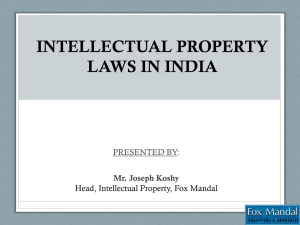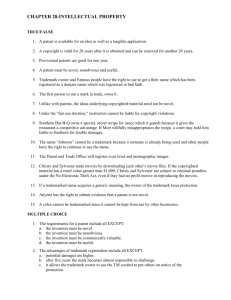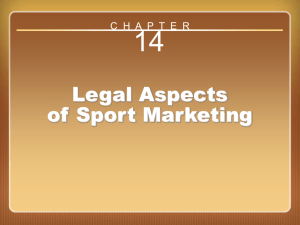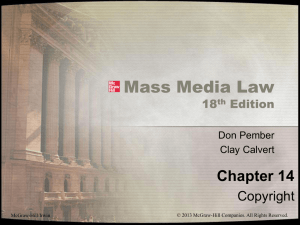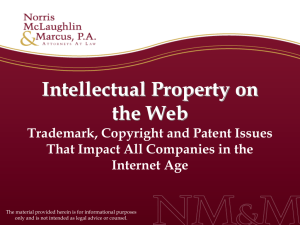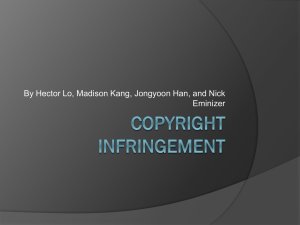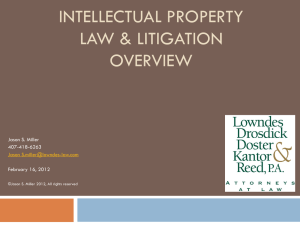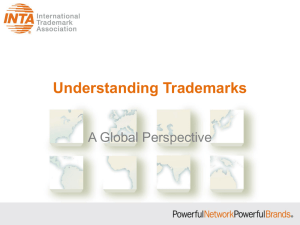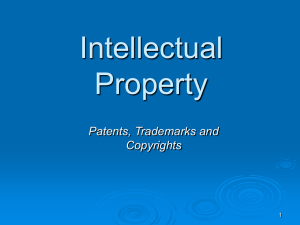Chapter 8
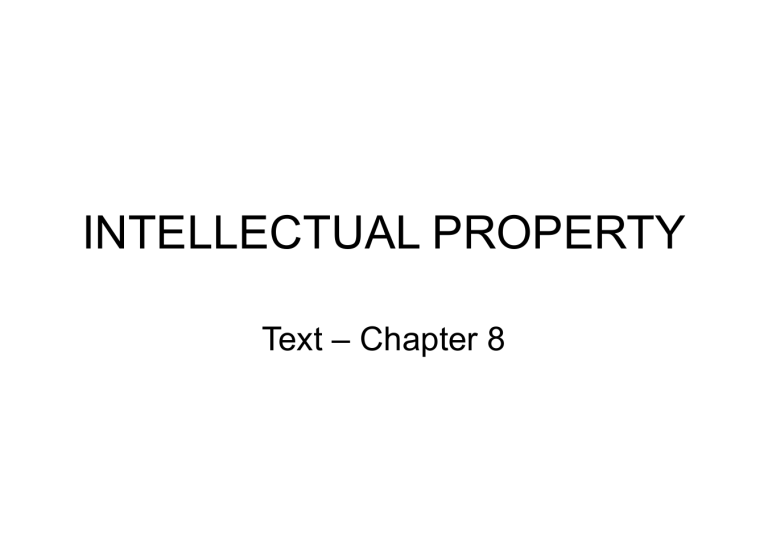
INTELLECTUAL PROPERTY
Text – Chapter 8
Learning Objectives
• Infringement of intellectual property rights
• Misappropriation of trade secrets
• Unfair competition - intentional torts
• Unfair competition – the Lanham
8 - 2
Act
Types of Intellectual Property
• PATENT:
– Engine design, business methods
• TRADEMARK
– Logo, trade name
• COPYRIGHT
8 - 3
– Sales materials, artwork
Copyright
• Intangible right granted by statute to the author or creator of certain tangible literary or artistic productions
– Can’t copyright an “idea”
• Applicable law: Copyright Protection
Act and the Copyright Term Extension
Act
• http://www.copyright.gov/
8 - 4
Copyright
• Protection automatic; registration not required, though recommended
• Works created after 1/78 are given protection for life of author + 70 years
• Protection for a work-for-hire
(corporation owns copyright) is 95 years from first publication or 120 years from creation, which ever
8 - 5 comes first
Metro-Goldwyn-Mayer Studios,
Inc. v. Grokster, Ltd.
• Facts & Procedural History :
8 - 6
– Defendants Grokster and StreamCast
Networks, Inc. distributed free software that allowed computer users to share electronic files through peer-to-peer networks
– Many copyright owners (collectively referred to as MGM) filed separate lawsuits against defendants and the cases were consolidated
– MGM sought damages and injunction alleging that defendants knowingly and intentionally distributed software to enable users to reproduce and distribute copyrighted works in
Metro-Goldwyn-Mayer Studios,
Inc. v. Grokster, Ltd.
• Issue and Legal Reasoning:
8 - 7
– Issue is under what circumstances the distributor of a product capable of both lawful and unlawful use is liable for acts of copyright infringement by third parties using the product
– One infringes contributorily by intentionally inducing or encouraging direct infringement, and infringes vicariously by profiting from direct infringement while declining to exercise a right to stop or limit it
– Substantial evidence shows defendants acted with a purpose to cause copyright violations
Metro-Goldwyn-Mayer Studios,
Inc. v. Grokster, Ltd.
• Holding:
8 - 8
– One who distributes a device with the object of promoting its use to infringe copyright, as shown by affirmative steps taken to foster infringement, is liable for the resulting acts of
Patent
• Grant from federal government to an inventor in which inventor obtains exclusive right to make, use, and sell his invention for a period of 20 years (14 years for designs)
• U.S. Patent Act requires registration
8 - 9
– http://www.uspto.gov/
Patent
• A patent will not be issued if more than one year before the patent application the invention was patented elsewhere, described in a printed publication, or in public use or on sale in the United
States
• Example: Pfaff v. Wells Electronics,
Inc.
8 - 10
– Inventor sold patented item on April 8,
1981
– Inventor applied for a patent on April 19,
Patent
• Protection for: a process, a machine, a manufacture or product, a composition of matter ( such as a new chemical compound), an improvement of any of the above, an ornamental design for a product, a plant produced by asexual reproduction, certain business methods
• Even though an invention fits one
8 - 11 of the categories, it is not patentable if it lacks novelty, is
Trademark
• Distinctive mark, motto, device, or emblem that a manufacturer or service provider stamps, prints, or affixes to products it produces or services it performs to distinguish products or services from those of competitors
• Applicable law: Lanham Act
• Registration with state or fed. government recommended, but not
8 - 12 required
Trademark
• “Trademark” applicable to:
– trade name (e.g., McDonald’s, Nike)
– trade image (e.g., Ronald McDonald)
– trade logo (golden arches, swoosh)
– trade dress (red & white awnings of KFC)
• Trademark dilution is the diminishment of the capacity of plaintiff's marks to identify and distinguish plaintiff's
8 - 13 goods or services
E-Commerce Infringement
• Trademark dilution on the internet is prohibited by the Anticybersquatting
Consumer Protection Act
• Creates civil cause of action against a person who, with bad faith intent to profit from a trademark, registers, traffics in, or uses a domain name identical or
“confusing similar” to distinctive mark
8 - 14
– Example: Volkswagen sued Virtual
World for their registration of VW.com
and won
Work-for-Hire
• A work-for-hire exists when
– (1) an employee, in the course of her regular employment duties, prepares a copyrightable work; or
– (2) an individual or corporation and an independent contractor (i.e., nonemployee) enter into a written “hire” agreement under which the nonemployee prepares a copyrightable work for the individual or corporation
8 - 15
Infringement
• Violation of intellectual property right: when someone uses, makes, or sells another’s trademarked, patented, or copyrighted intellectual property without owner’s permission, license, franchise
• Penalties -- actual or statutory damages in civil proceedings or
8 - 16 criminal penalties for willful violations
Proof of Infringement
• Generally, infringement requires proof that:
– (1) defendant had access to copyrighted work;
– (2) defendant engaged in enough copying
(deliberately or subconsciously) that resemblance between allegedly infringing work and protected work could not be coincidental; and
8 - 17
– (3) substantial similarity exists between the works
The “Fair Use” Defense
• For copyright and trademark infringement, a “fair use” defense or exception exists when the copyrighted work or trademark is used without the property holder’s permission
8 - 18
– “for purposes such as criticism, comment, news reporting, teaching (including multiple copies for classroom use), scholarship, or research”
Section 107 of the
Copyright Act
The “Fair Use” Defense
• A court weighs factors in a fair use determination:
– (1) the purpose and character of the use,
– (2) the nature of the copyrighted work,
– (3) the amount and substantiality of the portion used in relation to the copyrighted work as a whole, and
– (4) the effect of the use on the potential markets for the copyrighted work or on its value
8 - 19
Exceptions/Defenses
• “Fair Use” may include parody
8 - 20
– Example: In Campbell v. Acuff-Rose
Music, Inc., the Supreme Court held that 2 Live Crew’s version of Roy
Orbison’s “Pretty Woman” was a parody and could be a fair use if the use was not excessive and did not harm the market for the original
• Case remanded to determine whether use was
“excessive” or “harmed the market,” but the two sides eventually settled with 2 Live Crew paying royalties
Mattel, Inc. v. Walking Mountain
Productions
• Facts & Procedural History :
8 - 21
– Plaintiff artist produces works with social and political overtones, including a 78-photograph series titled “Food Chain Barbie”
– Forsythe describes the artworks as an attempt to “critique the objectification of women associated with [Barbie], and [to] lambaste the conventional beauty myth and the societal acceptance of women as objects.”
– Mattel sued Forsythe alleging that the series violated Mattel’s copyright and trademark rights in regard to the Barbie doll’s
Mattel, Inc. v. Walking Mountain
Productions
• Issue :
– Did defendant’s use of Mattel’s intellectual property infringe on Mattel’s rights?
• Law Applied to Facts :
8 - 22
– Because Forsythe reproduced photographs of the Barbie figure, Mattel established a prima facie case of copyright infringement
– However, the Copyright Act recognizes certain statutory exceptions to protections on copyrights
Mattel, Inc. v. Walking Mountain
Productions
• Legal Reasoning and Holding :
8 - 23
– “Purpose and character of use” factor in a fair use inquiry asks “to what extent the new work is transformative” and does not “supplant” original
• Parodic works comment and criticize, thus often sufficiently transformative to fit under fair use exception
– Given extremely transformative nature and parodic quality of Forsythe’s work, the first fair use factor weighs heavily in favor of Forsythe
– All other factors also weigh in favor of
International Law
• International intellectual property law is governed by multilateral agreements
– Paris Convention
– Madrid Agreement Concerning the International
Registration of Trademarks
– Madrid Protocol
– World Trade Organization’s Agreement on Trade-
Related Aspects of Intellectual Property Rights
(TRIPS)
• World Intellectual Property Organization
8 - 24 (WIPO) resolves international intellectual property disputes
Test Your Knowledge
• True=A, False = B
– You may copyright an idea
8 - 25
– Copyright protection requires registration with the U.S. Copyright
Office
– The U.S. Patent Act requires registration of a patent to obtain protection for the intellectual property
– The Lanham Act protects trademarks
Test Your Knowledge
• True=A, False = B
– Trademark dilution refers to the overuse of a trademark on products or services
– An employee who creates a new software program has made a workfor-hire
8 - 26
– The “fair use” defense is an absolute defense to an infringement claim
Test Your Knowledge
• Multiple Choice
8 - 27
– A trademark refers to:
• (a) trade name
• (b) trade image
• (c) trade logo
• (d) trade dress
• (e) all of the above
– Trademark dilution on the internet is prohibited by:
• (a) Anticybersquatting Consumer Protection Act
• (b) Patent & Trademark Act
• (c) Berne Convention
Trade Secrets
•
Trade secret:
any secret formula, pattern, process, program, device, method, technique, or database used in the owner’s business that gives the owner competitive advantage
• A firm must take reasonable
8 - 28 measures to maintain secrecy
Misappropriation
• Misappropriation of a trade secret occurs when a person discloses or uses after acquiring the secret:
8 - 29
– By improper means (theft, trespass, etc.)
– Through another party who is known or should have been known to have obtained the secret by improper means,
– By breaching a duty of confidentiality
• Example: North Atlantic Instruments,
North Atlantic Instr. v. Haber
• Facts :
8 - 30
– North Atlantic manufactured electronic equipment
– The firm acquired TMI in which Haber was a
1/3 owner and president; Haber had substantial client base
– Acquisition of TMI conditioned on Haber’s continued employment since the client contacts were a valuable intangible asset
– Haber’s employment contract, with a confidentiality clause, ended in 1997, when he joined Apex, a firm with a similar target market
– North Atlantic sued Haber and Apex for
North Atlantic Instr. v. Haber
• Appellate Court Reasoning and
Ruling :
8 - 31
– Based on a magistrate’s findings, the trial court enjoined Haber and Apex from using the client contacts; Haber and Apex appealed
– The appellate court examined and agreed with the magistrate’s findings that the identity of North Atlantic’s client contacts was a protectable trade secret and agreed that
Haber had breached his duty of confidentiality
– District court’s injunction affirmed
Commercial Torts
• Commercial torts are intentional torts that involve business or commercial
8 - 32 competition and include :
– Injurious falsehood (product disparagement) involves the publication of false statements that disparage another’s business, property, or title to property, and thus harm economic interests
• Example: Jefferson County School District v.
Moody’s Investor’s Services, Inc.
Commercial Torts
• Commercial torts (cont.)
– Intentional interference with contractual relations occurs when one party to a contract claims that the defendant’s interference with the other party’s performance of the contract wrongly caused the plaintiff to lose the benefit of that performance
8 - 33
– Intentional interference with prospective advantage parallels the elements for interference with contractual relations,
Commercial Torts
• Commercial torts (cont.)
8 - 34
– Section 43(a) of the Lanham Act creates civil liability for unfair competition, including misleading, confusing, or deceptive representations made in connection with goods or services
• Example: American Italian Pasta Co. v.
New World Pasta Co ., in which the pasta companies battled over whether the defendant could claim its brand was
“America’s Favorite Pasta”
Thought Question & Participation
Assignment for Chapter 8:
• Music is intellectual property. What do you think about people who download music illegally? Have they committed
8 - 35 theft?



